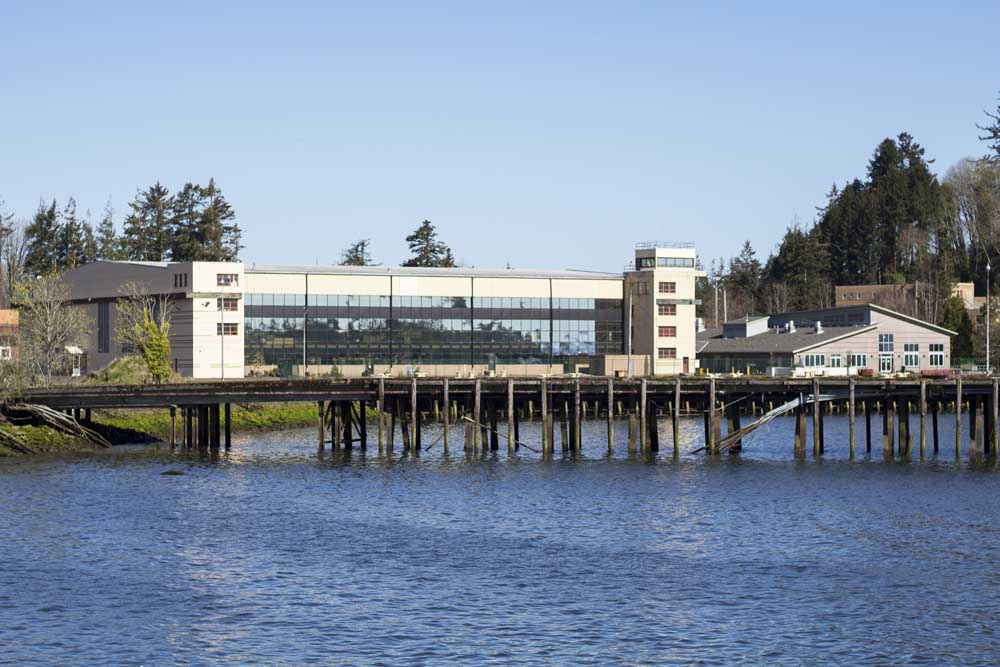Study launched for Willapa Bay ferry
Published 1:00 pm Tuesday, January 16, 2024

- Ilwaco Mayor Mike Cassinelli points out a feature on a chart of Willapa Bay to University of Washington graduate students and other local stakeholders at a meeting last Friday in Long Beach.
LONG BEACH, Wash. — Local stakeholders and graduate students from the University of Washington met last Friday to kick-start a study on the practicality of a passenger ferry in Willapa Bay that would connect the peninsula with communities in north Pacific County.
The feasibility study began in earnest inside the Long Beach Merchants Service Center last Friday morning, where six students from the University of Washington’s Foster School of Business met with local elected, business and tourism leaders to discuss the scope and aims of the endeavor. The students spent the remainder of the day traveling throughout the county and visiting potential ferry stops, including the Port of Peninsula, Port of Willapa Harbor and Tokeland Marina.
The work that will be conducted by the team of students comes via a partnership between the Pacific County Economic Development Council and the University of Washington’s Livable City Year program that began in the 2022-23 academic year and has since been extended. The program has worked with local governments and stakeholders in recent years to connect locally identified projects with students and courses who best align with the work.
The partnership initially focused on housing-related issues in Pacific County and has yielded valuable work, including an analysis of vacant or underdeveloped lands that could accommodate future growth, developing a database of properties that could be utilized to increase workforce and affordable housing and evaluating the zoning and permitting processes of the county and the four incorporated cities.
The prospect of a ferry operating on Willapa Bay has been long talked about, and the study represents the most serious push to date on making it a reality — if it actually proves to be viable.
Jeanne Brooks, the chair of Economic Development Council’s board who works as a strategist for Microsoft and co-owns a rental business with her husband, told the students last week that the work they and local partners are doing is critical to the life, welfare and safety of the county’s residents.
“You’re going to bring great brainshare and energy to this project,” she said.
Katja Spitz, the executive director of the Pacific County Tourism Bureau, said a ferry running between north county and the peninsula lines up with the bureau’s goals. She said it could make the area a more appealing destination for people visiting from the Seattle area and the Olympic Peninsula by chopping down on their driving time and avoiding the portion of U.S. Highway 101 between the peninsula and South Bend, which can be an uncomfortable drive at night or in rough weather.
Sue Yirku, the Economic Development Council’s executive director, explained to the students that Pacific County’s economy relies heavily on tourism and that a ferry connection would obviously be a positive development. But she said businesses, such as seafood companies operating locally, have also offered their support and believe this additional, quicker mode of transportation between the county’s most concentrated population areas would make things much easier on their workers and allow them to cast a wider net when it comes to hiring.
“It would allow the workforce to move from place to place,” Yirku said. “They’ve actually asked about that and they were really excited about this — the seafood companies — because recruiting workers (is difficult for them). I mean I just got a call yesterday, ‘Where can I get temp workers?’”
A healthy portion of the kickoff meeting on Friday was devoted to going over the wide range factors that will determine whether operating a ferry in the bay is actually feasible. A chart of Willapa Bay that showed its navigable channels was laid out on the table that the meeting attendees were huddled around.
Kelly Rupp, chair of the Pacific County Planning Commission and an Ocean Park consultant who has spearheaded local engagement, noted that Willapa Bay drains more water in one tide change than the Mississippi River drains in a day. “Twice a day,” he said, “you have this incredible exchange of water going in and out of this estuary.”
Responding to a question from a student about whether the tide could be too rough, Rupp said he didn’t believe that would be a problem within the bay. But he pointed out that some ferries, including those operating on Puget Sound, will sometimes have to adjust their schedules due to tidal conditions.
Mike Cassinelli, Ilwaco’s mayor and a longtime charter fishing operator, said the bay’s bar is “really movable.” Channels used to be dredged deep enough to take a vessel carrying logs out into the ocean, but have not been dredged in decades. However, he believes there’s a chance the only need for dredging would be for the ferry’s landing spots at the various locations.
Aside from practicality, whether operating a ferry is financially feasible is also something that the team of students will tackle.
A business plan detailing break-even scenarios for a small-capacity boat service needs to be developed that takes seasonal and year-round scheduling into account and outlines operating costs — such as fuel, maintenance and staff — and costs for the likes of insurance, licensing, marketing and sales operations.
Rupp said they are also looking for examples of comparable tourist ferry operations that can be identified and researched, as well as operational and liability concerns and what regulatory authorities would provide oversight.
The work from the group of students will come together over the next 10 weeks, and they will hold weekly check-ins with local stakeholders.
“It all fits logically but, (as others in the room) emphasized, we have no idea,” Rupp told the students. “We’ve been talking about this thing for years, but no one’s done the detailed work to see how this would play out. So we’re counting on you.”





